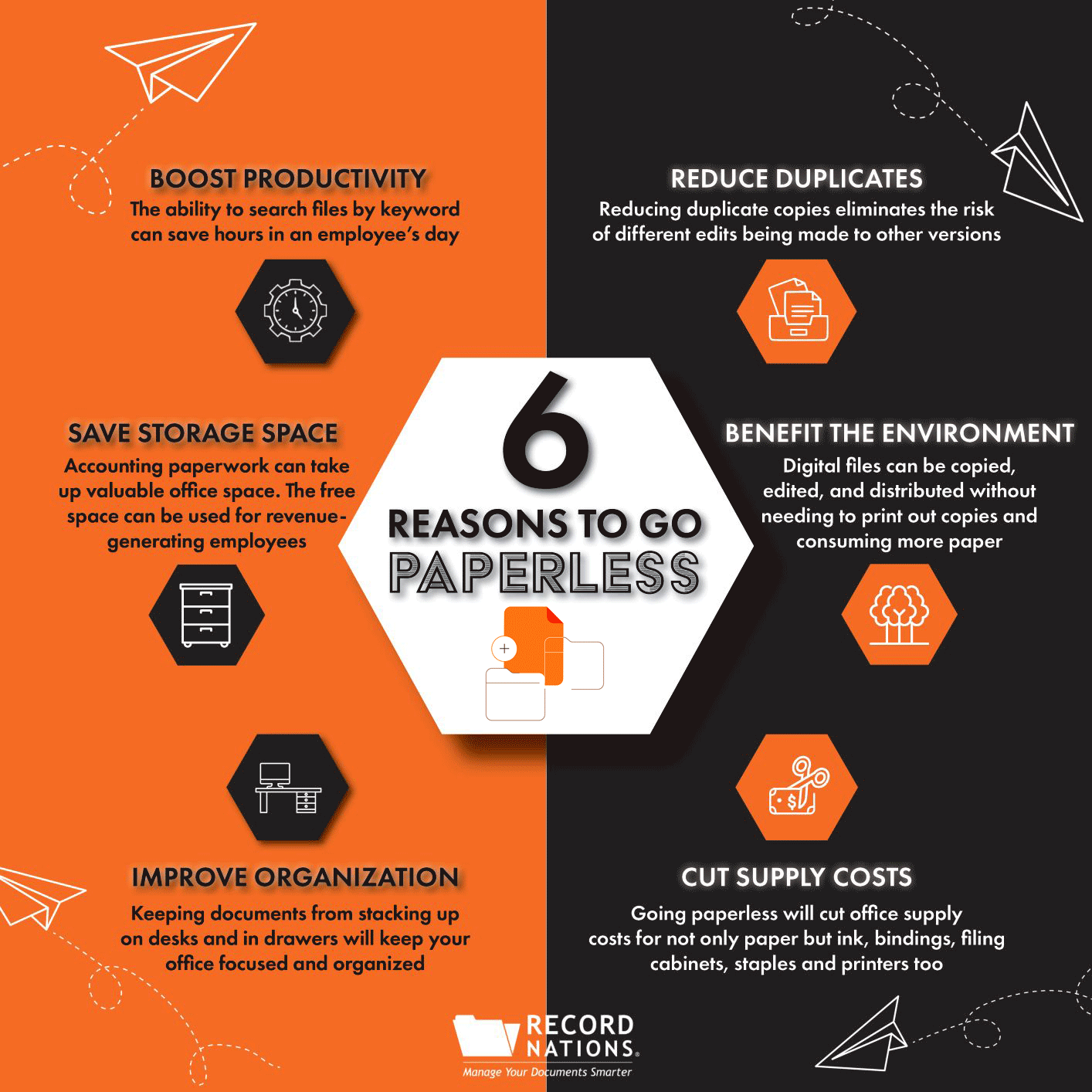
Going paperless in accounting makes a big difference in organization, efficiency, and waste reduction. The process can be daunting, but it’s worth it in the long run.
In the following video and blog, learn more about the process of going paperless in accounting. It explains the benefits of going paperless and outlines the steps on how to make the transition from paper management to digital.
Why Go Paperless in Accounting?
Staying on top of document management is especially important in accounting considering the amount of paperwork accounting departments and firms produce. Adopting a paperless system for managing records, it helps loosen the time and cost-efficiency bottlenecks that otherwise come with hard-copy document management.
Common files to scan include:
- Invoices
- Receipts
- Statements
- Purchase orders
- Account documents
- Loan documents
- Personnel files
- Delivery tickets
The Top 6 Reasons to Have Paperless Accounting
Among the many reasons to go paperless, some of the most compelling include:
Save Storage Space
Considering the amount of paperwork accounting firms can produce, adapting paperless records management will help to clear out the space-consuming filing cabinets in the office. This leaves the extra space for more productive purposes, like more revenue-generating employees.
Boost Productivity
Although finding and refiling a document doesn’t seem like it takes very long, when you multiply that by the number of employees and how many times they need to search for files per day, the time wasted quickly adds up. With paperless records management, the ability to search for files by keyword drastically reduces the time otherwise needed to track down papers and refile them (in addition to eliminating the chance of papers being filed in the wrong place).
Improve Organization
One of the biggest sources of office clutter is paper. However, scanning records provides an easy solution. You can reduce the amount of paperwork on desks and drawers by scanning them instead. Additionally, it helps employees stay focused and organized as well as make a better impression on clients.
Cut Supply Costs
Paper-based records management obviously includes the reoccurring cost of paper, but there are also indirect supply costs that a paperless office can eliminate:
- Filing cabinets
- Printers and ink
- Bindings (staple, paperclip, etc.)
- Tape, scissors, staplers, and glue
- Pens, pencils, and writing instruments
Benefit the Environment
Additionally, you can copy, edit, and distribute digital records without needing to print out multiple copies and consume additional paper. By eliminating the need to create duplicate copies, you in turn can help benefit the environment by reducing paper consumption.
Eliminate File Duplicates
Since you can edit digital files, it eliminates the need for a duplicate copy after updating. By limiting the number of duplicates, you’re able to ensure different edits apply to the original file instead.
How to Implement Paperless Accounting
Collect and Schedule
The paperless conversion process begins with the initial preparation for scanning. While organizing records before scanning, it’s recommended you label and separate file boxes based on their retention times. In addition, you should remove staples or paperclips to reduce the time it takes to scan. In turn, this cuts the cost of scanning documents.
Apply OCR and Redaction
When applying OCR (optical character recognition) and document redaction during scanning, it makes new digital files searchable, editable, and secure. With OCR the typed, handwritten, and printed text is converted into a machine-encoded text document that can be used just like any other word processing document. After applying OCR, redaction tools can digitally black out and obscure sensitive information.
Implement Storage
To share and store digital files either a centralized document management system (DMS) or cloud-based storage system needs to be implemented. Capabilities to be sure your storage system can handle include:
- Automated document routing after scanning to organize files
- Paperless bill, expense, statement, and report management
- Tools for depositing checks into remote banks or credit unions
- eSignatures for signing documents digitally
Shred Old Paper Copies
After the conversion process is complete its important to also take steps to properly dispose of paper documents. Many scanning providers either have an industrial shredder at their facility or instead partner with a shredding provider who can shred the documents either on site with a mobile shred truck or off-site at a shredding facility.
Once files are shredded you’re given a formal certificate of destruction which can be used as proof of compliance in case of legal disputes and includes details like where and when the shredding took place.
Ready to Enforce a Paperless Accounting Department?
Join countless other accounting firms and departments from companies including Amazon and Google who we’ve helped to find options for scanning and storing digital documents when you visit us at Record Nations today.
Transitioning to a paperless accounting firm is possible with our reputable network of providers. Let us help you find the best options for document scanning and record management systems. To receive a free quote, fill out the form, give us a call at (866) 385-3706, or contact us directly with our live chat.













